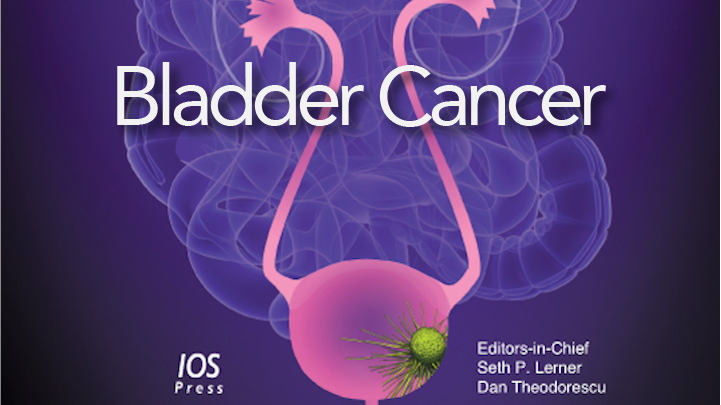
Bladder Cancer Journal Vol. 5 Issue 3
CIS of the Bladder: Significance and Implications for Therapy
Purpose of the review: To review the most recent literature with regards to the pathogenesis, diagnostics, clinical implications and treatment strategies for Carcinoma in Situ (CIS) of the Bladder. Recent findings: There have been advancements in understanding the genetic composition and biochemical behavior of CIS. Technological advancements including Photodynamic Diagnosis (PDD) with Hexaminolevulinate (HVA) better detect CIS compared to traditional white light (WL) cystoscopy. Recently published single and multi-center studies have enabled better understanding of the impact of CIS on clinical and cancer related outcomes, including disease recurrence and patient survival. Alternative intravesical chemotherapeutic and immunotherapies for CIS have been investigated, especially in the setting of Bacillus Calmette-Guerin (BCG) unresponsive disease. While these demonstrate a great deal of promise, they have not garnered much success. Summary: The genetics of CIS is linked to aggressive, and at times resistant disease, with increased cancer progression and associated clinically worse cancer specific outcomes. New technologies have enabled a more effective diagnosis of CIS. The development of a standardized definition for clinical trials and greater disease understanding will enable us to develop better treatment options.
Molecular/ Genetic/ Protein Characterizing of Bladder Cancer Circulating Tumor Cells
Background: Circulating tumor cells (CTCs) assays are a promising noninvasive way to interrogate the status of disease in bladder cancer. Since the molecular signature of cancer cells may dictate their susceptibility to targeted or immunotherapy, the full value of CTC assays may be in such subsequent characterization. These secondary features may help increasingly guide future clinical management of bladder cancer. Objective: This review aims to survey advances in the secondary molecular characterization of CTCs in bladder cancer. Methods: Using PRISMA guidelines, a systematic search of PubMed articles published between January 1990 to February 2019 was conducted
PD-L1/PD-1 Biomarker for Metastatic Urothelial Cancer that Progress Post-platinum Therapy: A Systematic Review and Meta-analysis
Background: Immune checkpoint inhibitors (ICI) are extremely expensive and most patients with metastatic urothelial carcinoma (mUC) do not benefit significantly from their use. Objective: We performed a systematic review and meta-analysis to determine response rates and survival outcomes on patients with mUC progressing despite prior platinum-based chemotherapy receiving ICI stratified by biomarker status. Methods: We performed a comprehensive literature search for all articles in PubMed and Embase up to 06/15/2019 to identify all studies pertaining to programmed death-ligand 1 (PD-L1) and programmed death 1 (PD-1) receptor targeted therapies for mUC that reported biomarkers. Given that biomarkers
Investigating the STING Pathway to Explain Mechanisms of BCG Failures in Non-Muscle Invasive Bladder Cancer: Prognostic and Therapeutic Implications
Background: Intravesical Bacillus Calmette Guerin (BCG) has been the gold standard immunotherapy to treat high risk non-muscle invasive bladder cancer (NMIBC) for over 40 years. Attenuation of Mycobacterium bovis for clinical use as BCG results in loss of its ability to activate the “Stimulator of Interferon Genes” (STING) pathway and potentially limits local anti-tumor immune activity and subsequent BCG responsiveness due to reduced induction of the immune cell recruiting chemokines primarily, CXCL10. We conducted the current study to determine the potential of STING pathway agonist in synergizing with BCG to enhance chemokine induction. Methods: The TICE strain of BCG (OncoTICE) was used in combination with STING agonist to determine STING pathway activation and CXCL10 production in THP-1 monocytic cell line, THP-1 defNLRP3, THP-1 dual STING knock out cells, RT112 bladder cancer cells and primary bladder epithelial cells. NanoString platform-based gene expression profiling and multiplex cytokine analysis were performed to determine induction of interferon associated genes and secreted cytokines. Results: Activation of cytosolic pattern recognition receptor and downstream IFN1 pathways demonstrated synergistic activation of STING pathway enhanced BCG induced inflammasome and STING pathway gene expression in monocytes and bladder cancer cells. The significant differences in CXCL10, CCL5, IL-8 and MIP-1a/1b amongst the knock-out cell lines confirm the convergence of these pathways following combination treatment with BCG and STING agonist. Conclusions: Findings from our study are the first evidence indicating that STING pathway activators are promising new innate immune modulators with a potential to synergize with BCG therapy in the treatment of NMIBC.

